
Culinary careers are sizzling again as the hospitality and restaurant industry bounces back from the pandemic and seeks to fill the positions vacated during the COVID-19 downturn. Chaffey College is doing its part to get more cooks in the kitchen.
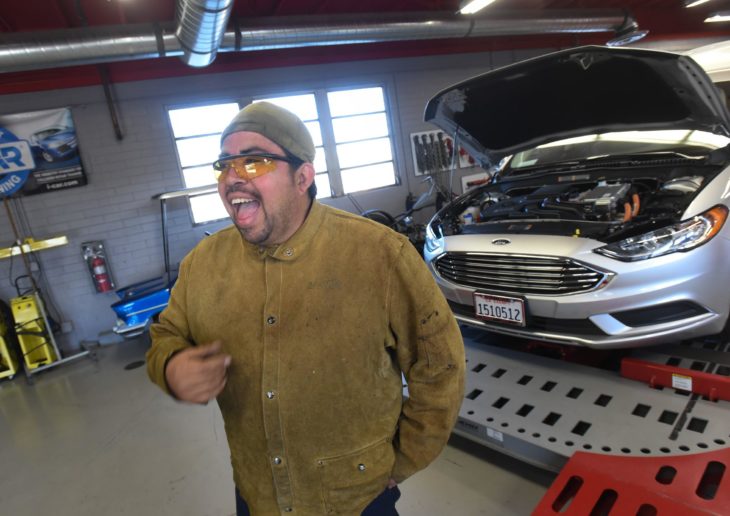
 San Bernardino, California – March 2018. Edgar Ramierez, 42, has been a car mechanic most of his life. So what is he doing in the automotive technology lab at San Bernardino Valley College? “I was afraid to go back to school,” he said. “I was terrified.” But it was a blessing in disguise. “This is the future,” Ramierez said as he gazed at the silver 2017 Ford Focus hybrid electric car just purchased with Strong Workforce funding. In his years taking automotive and welding classes, he has gone from a C average technician to an A plus technician. And he now feels confident around electric and hybrid engines.
San Bernardino, California – March 2018. Edgar Ramierez, 42, has been a car mechanic most of his life. So what is he doing in the automotive technology lab at San Bernardino Valley College? “I was afraid to go back to school,” he said. “I was terrified.” But it was a blessing in disguise. “This is the future,” Ramierez said as he gazed at the silver 2017 Ford Focus hybrid electric car just purchased with Strong Workforce funding. In his years taking automotive and welding classes, he has gone from a C average technician to an A plus technician. And he now feels confident around electric and hybrid engines.
A resident of Yucaipa, he works part time in an auto shop even as he takes community college classes. And his new knowledge is paying off already in the workplace.
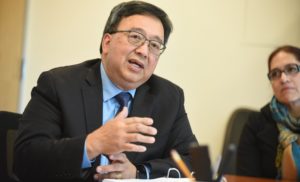 “Before, we were afraid of touching an electric vehicle,” he said. “We didn’t know the right way to work on them. We needed the right tools, insulated tools. We needed to disconnect the battery. Those orange wires are high voltage wires, and they can kill you if you don’t have the right training,” he said.
“Before, we were afraid of touching an electric vehicle,” he said. “We didn’t know the right way to work on them. We needed the right tools, insulated tools. We needed to disconnect the battery. Those orange wires are high voltage wires, and they can kill you if you don’t have the right training,” he said.
Training is the name of the game at California’s community colleges as they work with an infusion of money designed to create new pathways from training to jobs.
Albert Maniaol, dean of the Career and Technical Education programs at San Bernardino Valley College, says that the $1.2 million in new money from Strong Workforce has allowed the program to add more than just new hybrid electric cars. It has paid for a new job placement coordinator; a new chef to open a section on baking in the culinary program; it bought a 3-D printer for Graphic Arts; it expanded the equipment in the nursing program, including equipment only typically found in hospital settings.
 One piece of equipment, called a Pyxis, cost $49,000. It is standard in hospitals and it allows nurses with the right permissions to distribute medication securely. But understandably, the nurses do not want to share their access codes to students who are just starting their hospital-based training.
One piece of equipment, called a Pyxis, cost $49,000. It is standard in hospitals and it allows nurses with the right permissions to distribute medication securely. But understandably, the nurses do not want to share their access codes to students who are just starting their hospital-based training.
So San Bernardino Valley College bought one for the students.
“The students are only going to be allowed to do so much in a hospital setting,” said David Pengus, a nursing student who at 26 already has worked five years as an Emergency Medical Technician in Riverside. He sees nursing as the next logical step in a career that started with fire science. The job prospects in nursing are attractive. They always seem to be hiring. Based on that open job market, the SBVC nursing program has been expanding the number of students it serves.
The Strong Workforce philosophy is to expand programs with strong pipelines into the job market. So far, San Bernardino Valley has not had to cancel a program, but that is one of the realities of the Strong Workforce program. Funding is only available to sustain programs that lead directly to jobs in the local economy. Sometimes that means an equipment upgrade. But in other cases it means remaining with the older technology until the local job sites upgrade. “You cannot get ahead of what is being used in the local area,” Maniaol said.
In many professions, getting students into the workplace quickly can be effective. But In the case of healthcare, there is too much risk to let students be hands on with real patients. So the school recreates a hospital setting where the patients are mechanical. Mannequins are programmed by a technician to have spiking fevers and complaints of pain and nausea. Some of them talk and the students have to work in a realistic way to diagnose the symptoms. Then they watch a video replay to learn what they can do better next.
“It is a tough part of the learning process that sometimes a student mistake means the patient dies,” said Dr. Tamara Maurizi, a faculty member in Nursing who also serves as the Clinical Placement Coordinator when students are ready to work in a hospital setting. “It is so helpful that the early practice happens on mannequins.” She believes the hands on nature of the nursing program is critical to the 95 to 100 percent placement rate for San Bernardino Valley nursing students.
She said some students are invited back to serve in an advisory capacity. Or even as faculty members. Yubitza Castillo, who graduated in 2014, spent several years at a hospital but is now teaching in the program. “Nursing is stressful, but it’s worth it at the end,” she tells students.
One important new position, entirely funded by Strong Workforce money, is a job placement coordinator, Peggy Weber, who will reach out to employers, set up job fairs, and help track where each student ends up working.
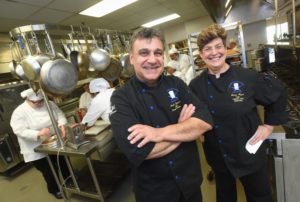 Some of those jobs might be in restaurants, especially in the bakery. San Bernardino Valley’s culinary program used Strong Workforce money to add a new baking expert, Sohrab Zardkohi, a chef who works with the current head of the department, chef Stacy Meyer.
Some of those jobs might be in restaurants, especially in the bakery. San Bernardino Valley’s culinary program used Strong Workforce money to add a new baking expert, Sohrab Zardkohi, a chef who works with the current head of the department, chef Stacy Meyer.
 The chefs in training have a new industrial oven to work with, a Rational brand oven that can proof, bake, roast, and hold large amounts of food for the projects of the culinary program. Meyer said she works closely with the American Culinary Federation to make sure that the standards at the Culinary program match with what is state of the art in the hospitality industry.
The chefs in training have a new industrial oven to work with, a Rational brand oven that can proof, bake, roast, and hold large amounts of food for the projects of the culinary program. Meyer said she works closely with the American Culinary Federation to make sure that the standards at the Culinary program match with what is state of the art in the hospitality industry.
In fact, Chef Danny Babin of the American Culinary Federation is now full time faculty at San Bernardino Valley College. The grant also paid for two laboratory technicians for the Culinary Arts program, Christine Camarena and Andres Dominguez.
Baking is the specialty of new faculty member chef Sohrab Zardkohi, pictured above with chef Stacy Meyer.

———————
Strong Workforce Program: To develop more workforce opportunity and lift low-wage workers into living-wage jobs, California took a bold step in 2016 to create one million more middle-skill workers. At the recommendation of the California Community College Board of Governors, the Governor and Legislature approved the Strong Workforce Program, adding a new annual recurring investment of over $200 million to spur career technical education (CTE) in the nation’s largest workforce development system of 114 colleges. For more information about Strong Workforce, please visit: http://doingwhatmatters.cccco.edu/StrongWorkforce/Overview.aspx.

Culinary careers are sizzling again as the hospitality and restaurant industry bounces back from the pandemic and seeks to fill the positions vacated during the COVID-19 downturn. Chaffey College is doing its part to get more cooks in the kitchen.
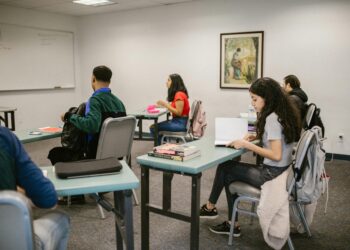
Dual Enrollment (DE) is catching on as students and their families recognize the advantages of earning college credit while still working towards high school graduation. But students aren’t the only… Read More – Good News for Community Colleges: Dual Enrollments Are on the Rise
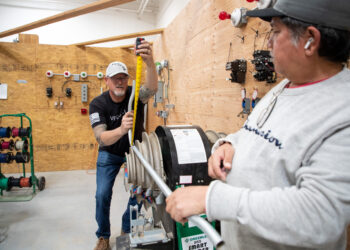
Enrollment in courses not offering credit toward a degree or certificate are outpacing for-credit programs in some states (Fed Communities). And it’s no wonder. With the convenience, minimal time commitment,… Read More – No Credit, No Problem: Noncredit Courses Gain Steam